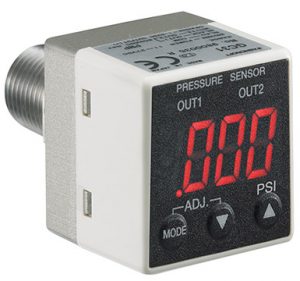What are common use cases for using a pressure sensor in predictive maintenance?
Pressure sensors alert maintenance teams when the pressure in a certain tank or piece of equipment falls outside of a specified level, allowing them to address the issue immediately. Although a change in pressure does not indicate an immediate failure, it could reduce efficiency, increase the burden on equipment, or contribute to a safety issue. Here are some typical applications of how pressure sensors contribute to predictive maintenance systems.

Pipeline or hydraulic hose pressure
Pressure sensors can monitor the fluid moving through these hoses. If pressure drops too low, a machine might require repair. If a pressure is too high, it can cause the hose to break or even explode.
Electronic transmitter set norms
If you’re running a production line with many steps, you may be relying on transmitters to gauge pressures throughout the system. Miniature devices can report the smallest variance to alert you to potential issues.
Low vacuum pressure
At one end of the spectrum, low vacuum or negative pressure gauges can measure down to under 150 psi in industrial applications. These tranducers work with gas and dry air and work best in high accuracy, repeatable applications.
High vacuum pressure
Industrial applications that require pressure readings of 10,000 psi or greater can benefit from high vacuum pressure gauges.
Energy conservation applications
Pressure sensors can help organizations reduce energy usage as well as their environmental footprint. They can be used in weather stations, within emissions testing devices, wind systems, research balloons, and pollution devices.
Technology industry applications
A myriad of pressure sensor applications exist within the sensitive equipment in the technology industry. They can be used to monitor air flow and printer ink levels as well as in altimeters and barometers. Semiconductor process equipment, IT cooling systems, clean rooms, and laser systems all benefit from pressure sensors.
Manufacturing applications
Quality control requirements often require pressure sensors to monitor tightly controlled processes. Problems with pressure or vacuum systems may signal preventive maintenance requirements before costs rise and downtime occurs. Pressure sensors can detect leaks, compressed air issues, and industrial flow problems. They can also check filter pressures, pneumatic controls, variable air volume systems, and industrial degassers.
¿Quieres seguir leyendo?
Mantenimiento predictivo
Los 6 sensores para el mantenimiento predictivo que optimizan los plazos de reparación
Lista de verificación de mantenimiento preventivo: consejos comunes para camiones y flotas
MÁS DE 4000 EMPRESAS CONFÍAN EN LA GESTIÓN DE OPERACIONES DE ACTIVOS
Liderando el camino hacia un futuro mejor para el mantenimiento y la confiabilidad
Los datos de sus activos y equipos no pertenecen a un silo. UpKeep simplifica ver dónde se encuentra todo, todo en un solo lugar. Eso significa menos conjeturas y más tiempo para concentrarse en lo que importa.


![[Review Badge] GetApp CMMS 2022 (Dark)](https://www.datocms-assets.com/38028/1673900459-get-app-logo-dark.png?auto=compress&fm=webp&w=347)
![[Review Badge] Gartner Peer Insights (Dark)](https://www.datocms-assets.com/38028/1673900494-gartner-logo-dark.png?auto=compress&fm=webp&w=336)
